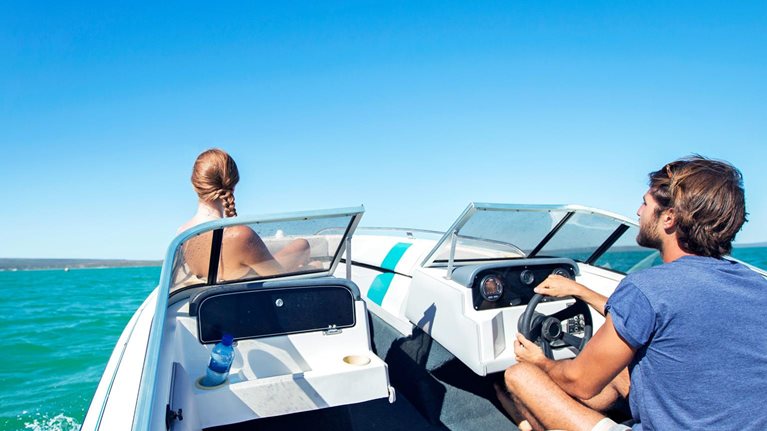Builders of boats—which we define, for the purposes of this article, as recreational boats and yachts of any size—face a unique challenge. They need to balance stringent customer demands for a bespoke, high-performance product with the need to remain profitable in the face of mounting cost pressures,1 talent shortages,2 and supply chain volatility.3
The value at stake is significant. According to McKinsey analysis, the global new boat sales market—which is estimated to be worth about $40 billion to $50 billion annually4—consists of around 200 midsize to large builders producing around 8,000 boats and yachts of 12 meters or more every year.5
The next wave of value creation will come from the following five levers:
- Design to willingness to pay aligns vessels to clear buyer archetypes, avoiding feature overload.
- AI-enabled engineering cuts design cycles by up to 70 percent, according to McKinsey analysis, enabling more iterations and better performance at lower cost.
- Advanced procurement goes beyond cost cutting to build resilience and transparency across multitier suppliers.
- A digital go-to-market strategy that incorporates environmental considerations helps engage younger, sustainability-minded buyers.
- Aftersales services, which remain underdeveloped, can become a recurring-revenue engine, capturing more lifetime spend via predictive maintenance, refits, and lifestyle services.
In our experience serving global recreational boating and shipbuilding clients over the past decade, these levers can, taken together, deliver 15 to 20 percentage points of EBITDA uplift while also reshaping how builders design, sell, and service vessels. This article unpacks each lever, illustrated with real‑world examples, data‑driven frameworks, and practical guidance for leaders aiming to transform design and operations for maximum value. Those that adopt this integrated playbook will be well placed to balance personalization with profitability and to capture growth and protect brand equity in a fast-evolving market.
Five levers can drive growth and boost margins
Taking action across five levers can help ensure boat builders are producing a product that meets or exceeds customer expectations and builds market share while also maximizing profitability. In our experience, optimization across these levers can increase EBITDA by 15 to 20 percentage points (Exhibit 1).

1. Design to willingness to pay: Embedding customer value in every design decision
Design to willingness to pay starts not with technical ambition or internal cost targets but with a sharp understanding of the end customer—and what they are willing to pay for a truly differentiated product. In boating, where customization can lift price tags into the hundreds of millions, aligning design choices with buyer value can, in our experience, unlock around five to ten percentage points of margin.
Unlike the mass market, luxury boating rewards scarcity and specialization. The goal is not only adding features but also shaping a portfolio around distinct buyer archetypes—such as performance seekers, family cruisers, and charter operators—while maintaining production focus and pricing power. Done right, Design to willingness to pay shifts the conversation from feature optimization to strategic value creation.
To operationalize Design to willingness to pay in the short term, companies can follow a four-step approach that blends market insight with design precision:
- Undertake voice-of-customer deep dives. Builders can define buyer archetypes and their unmet needs through the use of surveys, interviews, brokerage, and showroom visits. It may be, for example, that owners are prepared to accept lower cruising speeds in exchange for larger recreational areas or lower CO₂ emissions.
- Triangulate findings through attribute-level benchmarking. Builders can validate initial insights using targeted owner groups and online buzz analytics, complemented by side-by-side comparisons of key product attributes. These comparisons might include, for example, comparing the performance of silent air-conditioning technology or thermal zoning with that of competitors.
- Surface high-impact, quick-win opportunities. Builders can use expert commentary and subassembly teardowns to validate findings and pinpoint fuel inefficiencies. One quick win to increase fuel efficiency, for example, could be achieved by replacing overdesigned teak-and-steel deck furniture with lighter modular composites.
- Prioritize and scale. By the end of the process, builders should have defined a list of priority features to explore further, with the goal of achieving measurable cost improvements through focused design interventions.
2. AI in engineering: Accelerating development with predictive design
In our experience, traditional design loops—which move from computer-assisted design to simulations to prototypes—can take eight to 12 months to develop a new hull or structural frame. In our experience, AI-enabled methods, such as deep-learning surrogates and generative-design algorithms, can cut that timeline by 50 to 70 percent. These technologies and methods enable more iterations, faster innovation, and reduced dependence on the shrinking labor pool of key talent such as naval architects and marine engineers.
The impact goes beyond speed. According to McKinsey analysis, deep-learning surrogates trained on both physical and numerical simulation data can replicate computational-fluid-dynamics results with around 90 percent accuracy in under a minute, versus 12 to 24 hours per run for conventional models.
Generative-design tools further enhance results by proposing thousands of structural layouts under load constraints. Interviews with engineering and technical department experts suggest that this method can produce structures that are around 12 percent lighter and 15 percent stronger, translating directly into fuel and operating-cost savings. Beyond hulls and propellers, AI can also optimize structural rigidity, hydro-acoustics, HVAC, and vibration control, each contributing incremental performance and durability improvements.
Together, these applications represent a step change in design productivity. By compressing timelines, multiplying design options, and unlocking efficiency gains, AI can relieve acute talent shortages and create vessels with superior performance at lower life cycle costs.
3. Advanced procurement: Building resilient, value‑driven supply networks
Procurement has become a frontline challenge in boat building, as it has for many other industries. Rising customer expectations, inflation, and supply chain shocks are squeezing margins, while scarce talent and global disruptions expose the limits of traditional sourcing models.6 To stay competitive, builders must move beyond transactional procurement. They will need to embed resilience and value creation across the supply chain and address the full suite of levers related to procurement—from reducing overspecification in design to minimizing assembly waste and life cycle costs (Exhibit 2).

The value at stake is material. One boat builder used a mixture of these levers to significantly decrease procurement costs, including by reverse engineering a supplier proposal, which revealed an undisclosed 18 percent markup and enabled a renegotiation that cut costs by 12 percent. It also used multitier risk mapping to identify hidden bottlenecks in second- and third-tier suppliers, leading to dual sourcing and a 40 percent reduction in lead-time risk. Last, preassembly of interiors shaved three weeks off yard schedules and reduced rework by 25 percent.
4. Go‑to‑market strategy: Enabling digital and sustainable engagement for next‑gen buyers
Boat sales are shifting from a broker-dominated model to a customer-led ecosystem. At the same time, a new generation of buyers—younger, digital native, and more sustainability conscious—are bringing different engagement expectations and priorities.
Digital engagement is now table stakes. Many of today’s buyers expect direct, transparent engagement with brands long before stepping aboard. Social platforms are replacing cold outreach; 76 percent of next-generation buyers access Instagram daily, and 34 percent report that social media ads have influenced luxury purchases.7 Content is increasingly innovative, ranging from curated video journeys to behind-the-scenes built stories, which can create emotional hooks that drive deeper interest. Immersive tools such as augmented- and virtual-reality configurators can also allow potential buyers to explore layouts, personalize finishes, and interact with digital twins. In our experience, builders using these approaches have seen up to 25 percent more qualified leads and 15 percent shorter sales cycle times.
Postsale, the digital experience continues. Real-time factory build updates, digital twins, owner apps, and Internet of Things (IoT)–enabled monitoring systems foster trust and transparency. To build loyalty, builders are also experimenting with digital community-building tools such as nonfungible tokens, private digital clubs, and exclusive experiential events. Around 70 percent of next-gen buyers are open to virtual asset purchases, and those who feel connected to a brand’s ecosystem are around 60 percent more likely to buy adjacent services such as concierge, charter, or upgrades.
Expectations around sustainability are rising. A generational shift is reshaping boat ownership: The average age of buyers has dropped from around 60 to around 50,8 and younger buyers place greater weight on sustainability and transparency. Regulators are also tightening standards around sustainability; around 60 countries have already submitted national targets for 2035 emissions reductions.9
For builders, this increased focus on sustainability is both an opportunity and an imperative. Investments in greener propulsion, recyclable interiors, and energy-efficient hulls not only meet tightening regulations but also enhance resale value and support premium pricing. Those that are slow to act against announced ambitions may be placing brand loyalty at risk. To lead rather than follow, builders should go beyond compliance by sourcing sustainable and recyclable materials; applying efficiency by design through digital hull simulation; exploring the development of electric, hybrid, or sustainable-fuel-using boats; investigating sustainability-linked financing to align economics for buyers and builders; and reinforcing brand purpose with emissions tracking and partnerships.
The key is a credible full story—linking design choices to real savings, improved efficiency, and measurable impact—paired with a thoughtful and realistic implementation plan. Done right, these actions strengthen trust with the next generation of owners and protect long-term brand equity.
5. Aftersales: Turning service into a recurring‑revenue engine
Aftersales remains one of the largest untapped profit pools in boating. While owners spend approximately 10 percent10 of the boat’s purchase price on maintenance, upgrades, and operations, builders typically capture only around 25 to 35 percent of lifetime spend.11
Leaders in adjacent manufacturing and auto industries have shown what’s possible. Predictive platforms and structured refit programs have proven especially effective. A major charter operator’s predictive alerts and bundled subscriptions, for example, drove a 30 percent higher renewal rate and a 25 percent uptick in upgrade kit sales. Overall, targeted aftersales investments have, in our experience, doubled overall EBIT within three to five years (Exhibit 3).

In boating, similar aftersales opportunities lie in the following areas:
- maintenance and repair via global rapid-response teams or certified local yards
- refits and refurbishments aligned to evolving owner needs or resale preparation
- spare parts and predictive platforms, with IoT-driven scheduling to cut downtime
- certified preowned programs that extend brand quality into secondary sales
- expansion into lifestyle ecosystems, including boat and crew management for absentee owners, premium marina networks with exclusive access and services, concierge offerings from provisioning to curated experiences, luxury deliveries (such as fine dining, wine, and flowers) directly to vessels, and chartering support to deepen relationships and brand equity
Investing across these areas can transform aftersales into a recurring-revenue powerhouse, helping builders capture share of wallet, extend customer lifetime value, and create defensible differentiation in a competitive market. In our experience, monetizing aftersales successfully can add three to five percentage points to EBITDA.
As is the case with many advanced industries, margins in boat building are being squeezed by inflation, talent scarcity, and volatile supply chains. The industry benefits, however, from a customer pool that is generally willing to pay for truly differentiated, high-performing products. Those that make the most of the five levers laid out in this article can achieve this personalization while also optimizing profitability, establishing a sustainable source of competitive advantage.

